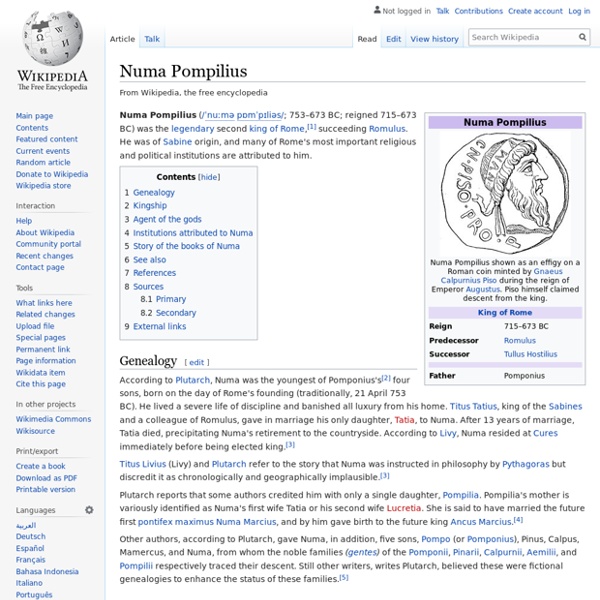Proserpina
Ancient Roman goddess Cult and myths[edit] Origin as Libera[edit] Libera was officially identified with Proserpina in 205 BC, when she acquired a Romanised form of the Greek mystery rites and their attendant mythology.
Dryope
In Greek mythology, Dryope (/ˈdraɪ.əpiː/; Ancient Greek: Δρυόπη derived from δρῦς drys, "oak"; dryope "woodpecker"[1]) is the name attributed to several distinct figures: See also[edit] Dryopia References[edit] Jump up ^ Graves, Robert, (1955) 1960. The Greek Myths.Jump up ^ Virgil, Aeneid, 10. 551Jump up ^ Gaius Valerius Flaccus, Argonautica, 3. 529 ff; Statius, Silvae, 1. 5. 22; 3. 4. 42Jump up ^ Statius, Thebaid, 2. 614 ffJump up ^ Gaius Valerius Flaccus, Argonautica, 2. 174
Pygmalion
Pygmalion or Pigmalion may refer to: Mythology[edit] Stage[edit]
Iole
Iole with Heracles in the house of Eurytus, as depicted on the 7th century Eurytos column-crater, Louvre. Iole's name is given in its Corinthian (Doric) form FIOLA ("Viola"), with digamma and a local Σ-shaped form for iota. It's located under the name of Herakles in the right upper corner of the image. Mythology[edit] Heracles' love for Iole leads to his death[edit]
Pyramus and Thisbe
Plot[edit] In Ovid's Metamorphoses, Pyramus and Thisbe are two lovers in the city of Babylon who occupy connected houses/walls, forbidden by their parents to be wed, because of their parents' rivalry. Through a crack in one of the walls, they whisper their love for each other. They arrange to meet near Ninus' tomb under a mulberry tree and state their feelings for each other. Thisbe arrives first, but upon seeing a lioness with a mouth bloody from a recent kill, she flees, leaving behind her veil.
King Eurytus of Oechalia
Image of King Eurytus of Oechalia in an Etruscan vase from Caere. Eurytus is depicted next to Heracles during a symposium. Krater of corinthian columns called 'Krater of Eurytus', circa 600 B.C. Family[edit] Eurytus' grandfather was Apollo, the archer-god, and was also a famed archer. Eurytus has been noted by some as the one who taught Heracles the art of archery.
Pyrrha
Deucalion and Pyrrha throwing rocks that become babies. Etymology[edit] In Latin the word pyrrhus means red from the Greek adjective πυρρός, purrhos, i.e. "flame coloured", "the colour of fire", "fiery red" or simply "red" or "reddish".[2][3] Pyrrha was evidently named after her red hair as Horace[4] and Ovid describes her as red haired. Mythology[edit] When Zeus decided to end the Bronze Age with the great deluge, Deucalion and his wife, Pyrrha, were the only survivors.
Dīs Pater
18th century painting showing Mercury (center), Flora (right), and Dīs Pater (left), from Convito per le nozze di Amore e Psiche (The Wedding Feast of Cupid & Psyche), Galleria Nazionale di Palazzo Spinola, Genova It is often thought that Dīs Pater was also a Celtic god. This confusion arises from the second-hand citation of one of Julius Caesar's comments in his Commentaries on the Gallic Wars (VI:18), where he says that the Gauls all claimed descent from Dīs Pater. However, Caesar's remark is a clear example of interpretatio Romana: what Caesar meant was that the Gauls all claimed descent from a Gaulish god that reminded him of the Roman Dīs Pater, a scholia on the Pharsalia equates Dis Pater with Taranis, the chief sky deity in the Gaulish religion.[1] Different possible candidates exist for this role in Celtic religion, such as Gaulish Sucellus, Irish Donn and Welsh Beli Mawr, among others.
Ionians
The location of ancient Ionia on the coast of modern-day Turkey. When referring to populations, “Ionian” defines several groups in Classical Greece. In its narrowest sense, the term referred to the region of Ionia in Asia Minor. In its broadest sense, it could be used to describe all speakers of the Ionic dialect, which in addition to those in Ionia proper also included the Greek populations of Euboea, the Cyclades, and many cities founded by Ionian colonists.
Pluto
Dwarf planet in the Kuiper belt of the Solar System Pluto (minor planet designation: 134340 Pluto) is a dwarf planet in the Kuiper belt, a ring of bodies beyond the orbit of Neptune. It was the first and the largest Kuiper belt object to be discovered. Pluto is the ninth-largest and tenth-most-massive known object directly orbiting the Sun.



